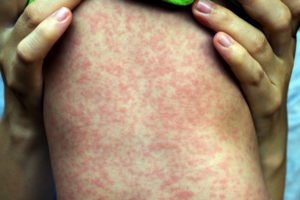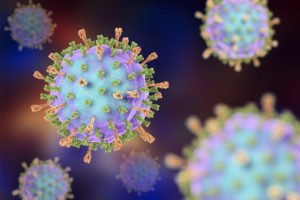The MMR vaccine is a combination vaccine that protects against three diseases: measles, mumps, and rubella. It’s a live vaccine, so it isn’t given to pregnant women or to immunocompromised patients.
When Do Kids Typically Receive the MMR Vaccine?
- The first dose of the MMR vaccine is administered between 12-15 months of age.
- A second (aka booster) dose is given between 4-6 years (usually before kids enter kindergarten). This dose is often given as part of a combination vaccine called ProQuad (MMRV), which includes the Varicella (chickenpox) vaccine too.
Insider Info: The ProQuad (MMRV) combination vaccine can technically be given at the 1-year visit as well, to cut down on the number of shots. However, doctors tend to give the MMR and Varicella vaccines separately at the 1-year visit, because studies have shown that there’s an increased risk of febrile seizures in children who get the MMRV vaccine between 12-15 months. Ask your child’s doctor for his/her take on this.
Although the MMR Vaccine is Considered Safe Overall, Potential Side Effects Include:
- Soreness at the injection site (this is common).
- An allergic reaction (this is uncommon).
- Swelling of the glands in the cheeks.
- A measles-like rash (that resolves on its own).
- Febrile seizures-especially when the MMRV (aka ProQuad) vaccine is given at an early age.
Let the doctor know if your child develops any of the above symptoms after he/she receives the MMR vaccine at the 1-year visit.
Now, Let’s Talk About the Diseases That the MMR Vaccine Protects Against…
Measles

Measles (fancy name: Rubeola) is a viral disease that can be deadly, particularly in the very young and the very old.
What are the Classic Symptoms of Measles?
- The “3 Cs”-cough, coryza (a runny nose), and conjunctivitis (pink eye).
- A high fever.
- A head-to-toe rash.
- Koplik spots-tiny white spots in the mouth surrounded by a red ring.
- Organ involvement (think: pneumonia or a brain infection) in severe cases.
Here’s a Typical Measles Presentation:
Day 1: The child develops cold-like symptoms (a cough and a runny nose) plus pink eye and a robust fever.
Days 3 & 4: Koplik spots appear in the mouth.
Days 5 & 6: An impressive rash breaks out all over the child’s body. At this point, the virus may travel to other organs (such as the lungs or the brain) and infect them.
Insider Info:
The measles rash usually starts out on the face. It then moves downward, spreading to the chest, back, arms, and legs. The rash is characterized by multiple small red bumps that coalesce to form larger red patches (as in the pic below).

PediaTrivia:

Back in the day, measles was fairly common. However, the introduction of the measles vaccine in 1963 caused the number of measles cases to drop significantly (by 99%). Measles was even declared eradicated in the U.S. in 2000.1
Eradicated? But I Thought Measles Was Still a Thing in the U.S.?
Yup, You’re Right! Measles has made a comeback in the U.S. in recent years (think: the Disneyland outbreak in 2015 and the current surge in measles cases in Ohio).
Why Did This Happen?
For 3 Main Reasons:
1. The reintroduction of the measles virus through international travel.
2. A rise in the number of parents refusing to vaccinate their children.
3. Children getting behind on their immunizations as a result of the COVID-19 pandemic.
Get Wiser About the Resurgence of Measles, here.
Common Question: What Should I Do if My Child is Exposed to Measles (Either Through an Outbreak in the Community or Through International Travel)?
- If the exposure happens before your child receives the MMR vaccine at his/her first-year checkup, then he/she can get the vaccine early (between 6-11 months).
- If the exposure occurs after your child has received the 1st dose of MMR, the 2nd (booster) dose of MMR can be moved up if needed. This second dose can be given as early as 28 days after the first dose.
Caveat: Any MMR vaccine that’s given before 1 year of age doesn’t “count” towards a child’s school record. He/she would need another dose of MMR at 12-15 months (plus the booster dose at 4-6 years of age) to complete his/her MMR vaccine requirement.
Mumps

The mumps vaccine represents the second “M” in the MMR vaccine.
Mumps is caused by an exotic-sounding virus called paramyxovirus.
The mumps virus initially causes cold-like symptoms and a fever. It then attacks different parts of the body, leading to painful swelling. The mumps virus is particularly known for invading the:
1. Salivary glands of the face, leading to cheek and jaw swelling (fancy name: parotitis),
AND
2. The testicles, leading to swelling of the scrotum (fancy name: orchitis)
Unfortunately, the mumps virus can also infect the brain. Fortunately, the mumps vaccine can prevent all of this.
Rubella (aka “German Measles”)

The “R” in the MMR vaccine stands for the Rubella vaccine.
Rubella is another viral infection. It’s also known as “German Measles” and is different and less severe than the “regular measles.”
Rubella typically causes only a mild infection in children (think: a low-grade fever, a sore throat, and a rash that starts on the face and spreads to the rest of the body). The rubella virus, however, poses a major threat to pregnant women (and to their developing babies).
How So? The virus can infect the fetus and cause a collection of birth defects (known as “congenital rubella syndrome”).
This is one of the reasons OB/GYNs make sure that women contemplating pregnancy are fully vaccinated. Remember, women who are already pregnant are NOT eligible for the MMR vaccine because it’s a live vaccine.
The Bottom Line
The MMR vaccine is an effective and easy way to prevent the unsavory illnesses discussed above.





